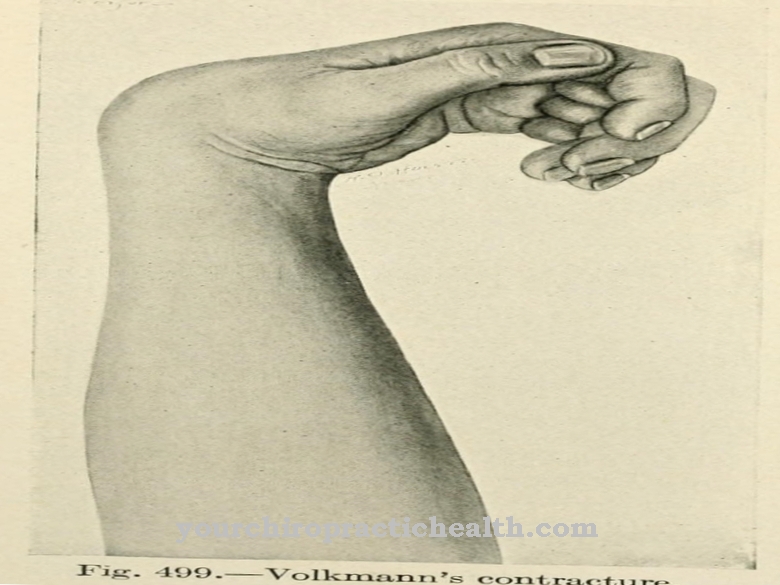The clinical picture of Uterine inflammation, Cervicitis, Endometritis or Myometritis is a classic pathological impairment in women of different age groups due to the anatomical characteristics.
What is uterine inflammation?

© Artemida-psy - stock.adobe.com
The uterine inflammation, which can affect even young women, is also known as cervicitis, endometritis or myometritis. In medical parlance, the ending -itis always indicates an inflammatory process. The uterine inflammation can affect different areas of the internal reproductive organs, especially the uterus.
In addition to the cervix, uterine inflammation can particularly affect the mucous membrane as the inner lining of the uterus. If the uterine inflammation is localized in the cervix, it is referred to as a cervicitis. If the lining of the uterus is directly affected, the uterine inflammation is called endometritis. Myometritis is an inflammation of the uterus that manifests itself in the muscles.
A uterine inflammation can be acute as well as develop into a chronic state. In most cases, the uterine inflammation heals with appropriate treatment without complications or consequential impairments. If left untreated, uterine inflammation can lead to inflammation of the fallopian tubes.
causes
Inflammation of the vagina is one of the causes of uterine inflammation. Special bacterial pathogens that rise through the vagina into the uterus and cervix cause uterine inflammation. The mucous membrane of the vagina is so resistant that bacteria cannot migrate to the higher organs. However, some strains of bacteria can do this under certain circumstances.
Inflammation of the uterus can be a result of natural processes such as births and miscarriages, mechanical contraceptives such as IUDs, abortions or surgical treatments on the internal reproductive organs.
Other possible causes of uterine inflammation are all processes that are associated with a change in the pH value of the vagina to the alkaline range. These are tumors, polyps, benign growths on the cervix or myomas.
The so-called chlamydia, gonococcal, strepto- and staphylococcal strains as well as Escherichia coli or mycoplasma bacteria belong to the bacterial pathogens that cause uterine inflammation.
Symptoms, ailments & signs
The symptoms of uterine inflammation depend on which part of the uterus is affected. If only the cervix is inflamed, mild symptoms occur, including an increased discharge. This is a white-yellow and sometimes purulent to bloody discharge of fluid that has a foul smelling odor.
The vagina may be itchy and painful because this is where the infection often originates. However, the lining of the uterus and the uterine muscles can also be inflamed. However, these inflammations do not cause any specific complaints. Often there is then lower abdominal pain and tenderness in the uterus.
The pain is often so severe that treatment with painkillers is even necessary. Sometimes menstrual disorders also occur, such as increased menstrual bleeding, prolonged periods, spotting or intermenstrual bleeding. Furthermore, discomfort when urinating in the form of burning sensation and constant need to urinate are possible.
If the infection spreads to the ovaries, the pelvic discomfort increases. Then there is a fever and a pronounced feeling of illness. Inflammation of the ovaries (adnexitis) is a complication of uterine inflammation and should definitely be prevented. Infertility can occur as a result of adnexitis. Usually uterine inflammation heals well. In rare cases, however, it turns into chronic inflammation with persistent discharge and infertility.
Diagnosis & course
The course of uterine inflammation is characterized by few or hardly any complications. This disease is easily treatable. Only permanent infertility and constant discharge can be the consequences of chronic uterine inflammation.
The achievable treatment success depends on the extent of the disease and the point in time when it occurs. What is meant in this context is an uterine inflammation that can only develop in the puerperium.
The diagnosis of uterine inflammation is based on laboratory and examination-specific measures by the attending physician. By examining the uterine lining with a colposcope, typical signs of inflammation can be seen. A laboratory medical examination of discharge or a smear from the cervix for bacteria can provide clear evidence of the existence of uterine inflammation.
Samples of the mucous membrane can be taken through a biopsy in order to differentiate the tissue changes in uterine inflammation from tumors. These are examined microscopically for appropriate cells.
Complications
Inflammation of the uterus can lead to various complications, but these only occur in rare cases. The disease takes a positive course in most patients. The risk of sequelae is also reduced by timely, professional treatment.
Complications from an uterine infection arise as the disease spreads. So there is a possibility that it will spread to the inner lining of the uterus. Even the entire wall of the uterus can be affected.
As the disease progresses, there is a risk of the inflammation rising to the fallopian tubes and ovaries, leading to salpingitis (inflammation of the fallopian tubes) and oophoritis (inflammation of the ovaries). If both body structures are affected at the same time, doctors speak of adnexitis.
Also within the realm of possibility is the accumulation of pus in the uterus from the inflammation. This mainly happens when the cervical canal is glued. Another dangerous, albeit very rare, consequence of uterine inflammation is peritonitis.
The endometritis spreads over the entire abdomen. This primarily affects women whose bodies are already weakened due to other diseases. Another possible reason is a disorder of the immune system.
Postpartum fever, also known as puerperal fever, is one of the serious complications of uterine inflammation. It occurs when the pathogens spread throughout the body via the bloodstream. Typical symptoms are pain, chills, and fever.
When should you go to the doctor?
Abdominal pain that cannot be associated with the onset of menstrual bleeding or ovulation should be examined and treated by a doctor. If you experience discomfort during the sexual act, a general malaise or cramps in the abdomen, a doctor's visit is necessary. If there are changes in the vaginal discharge, an unusual odor in the genital area or itching of the vagina, a doctor should be consulted.
A doctor should also be consulted as soon as you feel sick, restless or the body temperature is increased. If there are irregularities in the menstrual cycle, these should be clarified by a doctor. In the event of intermenstrual bleeding, shortened or prolonged bleeding or discoloration of the leaking fluid, these observations should be examined by a doctor. Spotting should also be clarified. A doctor is needed if irritability, mood swings, or feeling exhausted.
If the symptoms increase in scope and intensity, a medical examination should be initiated as soon as possible. If the itching leads to open wounds in the genital area, it is advisable to consult a doctor immediately before germs can enter the organism that can trigger further diseases. If a pulling or burning sensation in the abdomen can be felt repeatedly, this observation should be discussed with a doctor.
Doctors & therapists in your area
Treatment & Therapy
In addition to maintaining bed rest and taking antibiotic medication such as cipraflaxin, doxycycline or metronidazole, surgical interventions are also relevant.
In addition to antibiotics, pain-relieving medications complete the symptoms that arise during uterine inflammation and are given in particular in the event of severe inflammation.
The affected patients must be admitted to the hospital in the case of the risky courses of uterine inflammation. In addition to removing a coil as the cause of the uterine inflammation, a so-called uterine scraping can be carried out as a therapeutic measure.
During the procedure, tissue substances that cause inflammation, such as unreleased mucous membrane or placenta residues, are removed.
Outlook & forecast
The prognosis of uterine inflammation is favorable for most patients. With early drug supply, an improvement occurs within a few days. The existing symptoms recede and the uterus heals. A short time later you will be free of symptoms. Consequential damage or long-term impairments are normally not to be expected. Rapid healing is possible with sufficient rest and a stable immune system.
Without medical treatment, the symptoms that have arisen will increase. The inflammation spreads and the general health gradually deteriorates. There are irregularities in the monthly cycle and pain increases in intensity.
If the fallopian tubes or ovaries become inflamed as a result of missing or delayed treatment, the prognosis worsens. Various complications can arise that have a long-term impact on the patient's health.
In unfavorable cases, the patient is at risk of irreparable infertility. Pregnant women can miscarry due to the inflammation. If the uterine inflammation spreads into the abdomen, further functional disorders can set in. Digestive problems and urination arise. Irreparable organ and tissue damage is possible. There is also a risk of sepsis. The blood poisoning is potentially life threatening for the patient.
prevention
In order to prevent a renewed uterine inflammation after an illness, a so-called contraction agent can be taken. This favors a contraction of the uterus and a corresponding regression of the organ. Since in some cases of stubborn and severe uterine inflammation the ovaries and fallopian tubes can also be affected, antibiotics are usually also prescribed.
For personal prevention against uterine inflammation, condoms and good intimate hygiene are crucial in order to avoid vaginal inflammation first. Intimate washing lotions help ensure that the acidic and germicidal environment of the vagina cannot change and that rising bacteria do not cause uterine inflammation.
A regular check-up with an IUD in place as a contraceptive that sometimes triggers inflammation is useful in order to detect uterine inflammation in good time.
Aftercare
After a successfully treated uterine inflammation, there are usually no more symptoms. Follow-up care is therefore unnecessary. However, no immunity has built up. Another illness is possible. To prevent this, preventive measures are recommended.
The patient is responsible for this. The man should use a condom during sexual intercourse.It is imperative that the woman perform regular intimate hygiene. If tampons or sanitary towels are worn during the menstrual period, they must be changed after six hours at the latest. Uterine inflammation is also caused by a weakened immune system.
Patients are therefore advised to eat a varied diet and avoid stress. Analyzes of the discharge and a smear from the cervix provide clarity. Consequences of uterine inflammation only remain in rare cases. To prevent complications, a doctor may administer a contraction drug.
This promotes the regression of the organ. If the inflammation persists, antibiotics may be necessary. In the worst case, infertility and irreparable organ damage result from an uterine infection. These must be treated symptomatically, which often results in adjustments in everyday life. A desire to have children can no longer be fulfilled and sometimes there are malfunctions in urinating and ingesting certain foods.
You can do that yourself
The uterine inflammation is triggered by bacteria that migrate up the vaginal canal to the uterus. Hygiene in the genital area is therefore an essential factor in preventing inflammatory diseases or reducing their intensity. Regularly changing hygiene items during menstruation prevents bacteria build-up.
Tampons, sanitary towels or menstrual cups must be replaced after six hours of use at the latest. Good sexual hygiene is also essential and easy to implement. The use of condoms during sexual intercourse and extensive intimate hygiene help with uterine inflammation.
Washing lotions should be free from soaps or perfume for the genital area. The use of intimate sprays should be avoided if possible. This helps not to weaken the natural defense function of the mucous membrane. Regular showering or washing as well as changing underwear every day is necessary in order not to promote bacteria formation.
In addition to taking precautions, it helps to strengthen the immune system. With a healthy diet rich in vitamins, the body can build up defenses in order to fight bacteria on its own. Sufficient movement through sporting activities also supports the immune system.
Avoiding stress and overexertion promote well-being and prevent inflammatory diseases. After giving birth or miscarriage, the risk of uterine inflammation is increased. Therefore, intensive intimate hygiene is necessary, especially during this time.


.jpg)

.jpg)

.jpg)






.jpg)

.jpg)
.jpg)











.jpg)